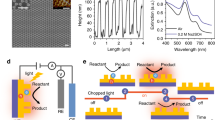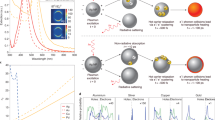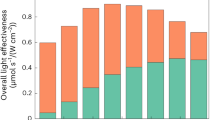Abstract
In Förster resonance energy transfer (FRET), energy non-radiatively transfers from a blue-shifted emitter to a red-shifted absorber by dipole–dipole coupling. This study shows that plasmonics enables the opposite transfer direction, transferring the plasmonic energy towards the short-wavelength direction to induce charge separation in a semiconductor. Plasmon-induced resonance energy transfer (PIRET) differs from FRET because of the lack of a Stoke's shift, non-local absorption effects and a strong dependence on the plasmon's dephasing rate and dipole moment. PIRET non-radiatively transfers energy through an insulating spacer layer, which prevents interfacial charge recombination losses and dephasing of the plasmon from hot-electron transfer. The distance dependence of dipole–dipole coupling is mapped out for a range of detuning across the plasmon resonance. PIRET can efficiently harvest visible and near-infrared sunlight with energy below the semiconductor band edge to help overcome the constraints of band-edge energetics for single semiconductors in photoelectrochemical cells, photocatalysts and photovoltaics.
This is a preview of subscription content, access via your institution
Access options
Subscribe to this journal
Receive 12 print issues and online access
$209.00 per year
only $17.42 per issue
Buy this article
- Purchase on Springer Link
- Instant access to full article PDF
Prices may be subject to local taxes which are calculated during checkout





Similar content being viewed by others
References
Shockley, W. & Read, W. T. Statistics of the recombinations of holes and electrons. Phys. Rev. 87, 835–842 (1952).
Bolton, J., Strickler, S. & Connolly, J. Limiting and realizable efficiencies of solar photolysis of water. Nature 316, 495–500 (1985).
De Vos, A. Detailed balance limit of the efficiency of tandem solar cells. J. Phys. D 13, 839–846 (1980).
Ross, R. T. & Nozik, A. J. Efficiency of hot-carrier solar energy converters. J. Appl. Phys. 53, 3813–3818 (1982).
Hanna, M. C. & Nozik, A. J. Solar conversion efficiency of photovoltaic and photoelectrolysis cells with carrier multiplication absorbers. J. Appl. Phys. 100, 075410 (2006).
Förster, T. Intermolecular energy migration and fluorescence. Ann. Phys. 437, 55–75 (1948).
Lessard-Viger, M., Rioux, M., Rainville, L. & Boudreau, D. FRET enhancement in multilayer core–shell nanoparticles. Nano Lett. 9, 3066–3071 (2009).
Lakowicz, J. R. Principles of Fluorescence Spectroscopy (Springer Academic, 2006).
Lunz, M. et al. Surface plasmon enhanced energy transfer between donor and acceptor CdTe nanocrystal quantum dot monolayers. Nano Lett. 11, 3341–3345 (2011).
Vasa, P. et al. Real-time observation of ultrafast Rabi oscillations between excitons and plasmons in metal nanostructures with J-aggregates. Nature Photon. 7, 128–132 (2013).
Dai, X. et al. Two-dimensional double-quantum spectra reveal collective resonances in an atomic vapor. Phys. Rev. Lett. 108, 193201 (2012).
Engel, G. S. et al. Evidence for wavelike energy transfer through quantum coherence in photosynthetic systems. Nature 446, 782–786 (2007).
Tabachnyk, M. et al. Resonant energy transfer of triplet excitons from pentacene to PbSe nanocrystals. Nature Mater. 13, 1033–1038 (2014).
Atwater, H. A. & Polman, A. Plasmonics for improved photovoltaic devices. Nature Mater. 9, 205–213 (2010).
Cushing, S. K. & Wu, N. Q. Plasmon-enhanced solar energy harvesting. Interface 22, 63–67 (2013).
Linic, S., Christopher, P. & Ingram, D. B. Plasmonic-metal nanostructures for efficient conversion of solar to chemical energy. Nature Mater. 10, 911–921 (2011).
Knight, M. W., Sobhani, H., Nordlander, P. & Halas, N. J. Photodetection with active optical antennas. Science 332, 702–704 (2011).
Furube, A., Du, L., Hara, K., Katoh, R. & Tachiya, M. Ultrafast plasmon-induced electron transfer from gold nanodots into TiO2 nanoparticles. J. Am. Chem. Soc. 129, 14852–14853 (2007).
Mubeen, S. et al. An autonomous photosynthetic device in which all charge carriers derive from surface plasmons. Nature Nanotechnol. 8, 247–251 (2013).
Leenheer, A. J., Narang, P., Lewis, N. S. & Atwater, H. A. Solar energy conversion via hot electron internal photoemission in metallic nanostructures: efficiency estimates. J. Appl. Phys. 115, 134301 (2014).
Giugni, A. et al. Hot-electron nanoscopy using adiabatic compression of surface plasmons. Nature Nanotechnol. 8, 845–852 (2013).
Warren, S. C. & Thimsen, E. Plasmonic solar water splitting. Energy Environ. Sci. 5, 5133–5146 (2012). .
Cushing, S. K. et al. Photocatalytic activity enhanced by plasmonic resonant energy transfer from metal to semiconductor. J. Am. Chem. Soc. 134, 15033–15041 (2012).
Li, J. et al. Ag@Cu2O core–shell nanoparticles as visible-light plasmonic photocatalysts. ACS Catal. 3, 47–51 (2013).
Li, J. et al. Plasmon-induced photonic and energy transfer enhancement of solar water splitting by a hematite nanorod array. Nature Commun. 4, 2651 (2013).
Meng, F., Cushing, S. K., Li, J., Hao, S., & Wu, N. Enhancement of solar hydrogen generation by synergistic interaction of La2Ti2O7 photocatalyst with plasmonic gold nanoparticles and reduced graphene oxide nanosheets. ACS Catal. 5, 1949–1955 (2015).
Nitzan, A. Chemical Dynamics in Condensed Phases (Oxford Univ. Press, 2006).
Varada, G. V. & Agarwal, G. S. Two-photon resonance induced by the dipole–dipole interaction. Phys. Rev. A 45, 6721–6729 (1992).
Sadeghi, S. M. Ultrafast plasmonic field oscillations and optics of molecular resonances caused by coherent exciton–plasmon coupling. Phys. Rev. A 88, 013831 (2013).
Zhang, W., Govorov, A. O., & Bryant, G. W. Semiconductor–metal nanoparticle molecules: hybrid excitons and the nonlinear fano effect. Phys. Rev. Lett. 97, 146804 (2004).
Zayats, A. V. & Maier, S. A. Active Plasmonics and Tuneable Plasmonic Metamaterials (Wiley, 2013).
Artuso, R. D. & Bryant, G. W. Strongly coupled quantum dot–metal nanoparticle systems: exciton-induced transparency, discontinuous response, and suppression as driven quantum oscillator effects. Phys. Rev. B 82, 195419 (2010).
Manjavacas, A., Nordlander, P. & Garcia de Abajo, F. J. Plasmon blockade in nanostructured graphene. ACS Nano 6, 1724–1731 (2012).
Jang, S., Cheng, Y. C., Reichman, D. R. & Eaves, J. D. Theory of coherent resonance energy transfer. J. Chem. Phys. 129, 101104 (2008).
Becker, P. C. et al. Femtosecond photon echoes from band-to-band transitions in GaAs. Phys. Rev. Lett. 61, 1647–1649 (1988).
Rosencher, E. Optoelectronics (Cambridge Univ. Press, 2002).
Li, Y., Zhao, K., Sobhani, H., Bao, K. & Nordlander, P. Geometric dependence of the line width of localized surface plasmon resonances. J. Phys. Chem. Lett. 4, 1352–1357 (2013).
Mauritz, O., Goldoni, G., Rossi, F. & Molinari, E. Local optical spectroscopy in quantum confined systems: a theoretical description. Phys. Rev. Lett. 82, 847–850 (1999).
Zhang, X. et al. Enhanced visible light photocatalytic activity of interlayer-isolated triplex Ag@SiO2@TiO2 core–shell nanoparticles. Nanoscale 5, 3359–3366 (2013).
Zhang, X. et al. Wavelength, concentration, and distance dependence of nonradiative energy transfer to a plane of gold nanoparticles. ACS Nano 6, 9283–9290 (2012).
Zhang, X. et al. Experimental and theoretical investigation of the distance dependence of localized surface plasmon coupled Förster resonance energy transfer. ACS Nano 8, 1273–1283 (2014).
Pinchuk, A. & Kreibig, U. Interface decay channel of particle surface plasmon resonance. New J. Phys. 5, 151 (2003).
Olsen, L. C., Bohara, R. C. & Urie, M. W. Explanation for low efficiency Cu2O Schottky barrier solar cells. Appl. Phys. Lett. 34, 47–49 (1979).
Palfrey, S. I. & Heinz, T. F. Coherent interactions in pump–probe absorption measurements: the effect of phase gratings. J. Opt. Soc. Am. B 2, 674–679 (1985).
Guenther, T. et al. Coherent nonlinear optical response of single quantum dots studied by ultrafast near-field spectroscopy. Phys. Rev. Lett. 89, 057401 (2002).
Link, S. & El-Sayed, M. A. Spectral properties and relaxation dynamics of surface plasmon electronic oscillations in gold and silver nanodots and nanorods. J. Phys. Chem. B 103, 8410–8426 (1999).
Frens, G. Controlled nucleation for the regulation of the particle size in monodisperse gold suspensions. Nature Phys. Sci. 241, 20–22 (1973).
Liz-Marzan, L. M., Giersig, M. & Mulvaney, M. Synthesis of nanosized gold–silica core–shell particles. Langmuir 12, 4329–4335 (1996).
Li, J. F. et al. Shell-isolated nanoparticle-enhanced Raman spectroscopy. Nature 464, 392–395 (2010).
Kuo, C. H., Hua, T. & Huang, M. H. Au nanocrystal-directed growth of Au−Cu2O core−shell heterostructures with precise morphological control. J. Am. Chem. Soc. 131, 17871–17878 (2009).
Acknowledgements
This work was supported by the National Science Foundation (NSF) (CBET-1233795) and NSF Graduate Research Fellowship under Grant No. (1102689). The resource and facilities were partially supported by the Army Research Laboratory (W911NF-14-2-0116) and NSF (EPS 1003907). The use of the West Virginia University shared facilities is appreciated.
Author information
Authors and Affiliations
Contributions
N.W. conceived the idea and concepts, and initiated, designed and guided the research. J.L. synthesized the test materials and conducted the photocatalysis measurements. S.K.C. also conceived the concepts, and conducted the transient absorption measurements, theoretical calculations and data analysis. F.M. and T.R.S. performed the microstructure characterization and materials testing. A.D.B. assisted with the analysis and discussion. S.K.C., N.W., J.L. and A.D.B. wrote the manuscript.
Corresponding author
Ethics declarations
Competing interests
The authors declare no competing financial interests.
Supplementary information
Supplementary information
Supplementary information (PDF 3249 kb)
Rights and permissions
About this article
Cite this article
Li, J., Cushing, S., Meng, F. et al. Plasmon-induced resonance energy transfer for solar energy conversion. Nature Photon 9, 601–607 (2015). https://doi.org/10.1038/nphoton.2015.142
Received:
Accepted:
Published:
Issue Date:
DOI: https://doi.org/10.1038/nphoton.2015.142
This article is cited by
-
Dual-plasmonic Au@Cu7S4 yolk@shell nanocrystals for photocatalytic hydrogen production across visible to near infrared spectral region
Nature Communications (2024)
-
Silver nanoparticle enhanced metal-organic matrix with interface-engineering for efficient photocatalytic hydrogen evolution
Nature Communications (2023)
-
Plasmonic phenomena in molecular junctions: principles and applications
Nature Reviews Chemistry (2022)
-
Electron and Energy Transfer Mechanisms: The Double Nature of TiO2 Heterogeneous Photocatalysis
Topics in Current Chemistry (2022)
-
ZnO:Ag nano-particles decorated hole transport layer for improved photon harvesting
Applied Physics A (2022)



